Russia is working on a reusable rocket
Not so long ago, the press center of TsAGI published an image of this model. Its appearance resembles many reusable spacecraft, such as the American Space Shuttle or our Buran. But the resemblance, as is often the case in life, is deceptive. MKRS-1 is a completely different system. It implements a fundamentally different ideology, which is qualitatively different from all past implemented space projects. At its core, it is a reusable booster.
The MRX-1 project is a partially reusable vertical take-off launch vehicle based on a winged reusable first stage, upper stages and disposable second stages. The first stage is performed by the aircraft scheme and is returned. It returns to the launch area in aircraft mode and makes a horizontal landing on airfields of the 1 class. The winged reusable block of the 1-th stage of the rocket system will be equipped with reusable cruise missile engines (LRE).
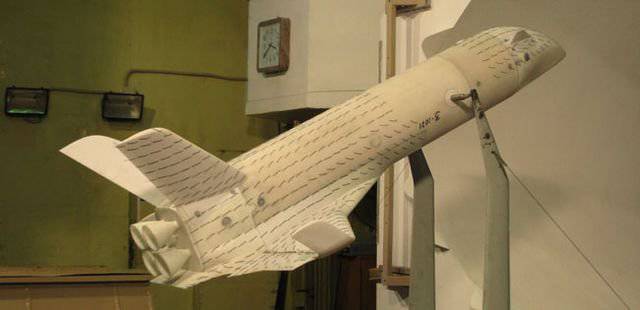
Currently in GKNPTs them. Khrunichev is in full swing designing and research work on the development and justification of the technical appearance, as well as the technical characteristics of the reusable space-rocket system. This system is created in the framework of the federal space program in conjunction with many related enterprises.
However, let's talk a little about stories. The first generation of reusable spacecraft includes 5 spacecraft such as Space Shuttle, as well as several domestic developments of the BOR and Buran series. In these projects, both Americans and Soviet experts tried to build a reusable spacecraft itself (the last step, which is directly displayed in space). The objectives of these programs were the following: the return from space of a significant amount of payloads, the reduction of the cost of launching a payload into space, the preservation of expensive and complex spacecraft for multiple use, and the possibility of frequent launches of a reusable stage.
However, the 1 generation of reusable space systems was not able to solve their problems with a sufficient level of efficiency. The specific price of access to space was approximately 3 times higher than ordinary disposable missiles. At the same time, the return from space of payloads has not increased significantly. At the same time, the resource of using reusable stages turned out to be significantly lower than the calculated one, which did not allow the use of these ships in a tight schedule of space launches. As a result of this, today both satellites and astronauts are delivered to Earth orbit using disposable rocket systems. And there is nothing at all to return expensive equipment and devices from the near-earth orbit. Only the Americans have made themselves a small automatic ship X-37В, which is designed for military needs and has a payload of less than 1 tons. It is obvious to all that modern reusable systems should be qualitatively different from those of the 1 generation.
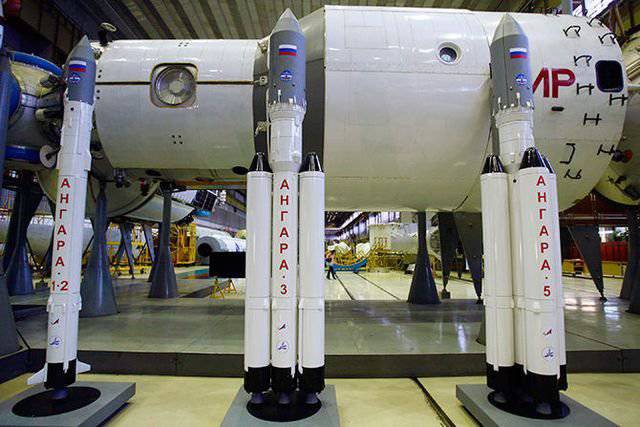
In Russia, work is underway on several reusable space systems. However, it is clear that the so-called aerospace system will be the most promising. Ideally, the spacecraft will have to take off from the airfield, like an ordinary plane, go into near-earth orbit and return back, using only fuel. However, this is the most difficult option, which requires a large number of technical solutions and preliminary studies. Quickly this option can not be implemented by any modern state. Although Russia has a fairly large scientific and technical reserve for projects of this kind. For example, the "aerospace plane" Tu-2000, which had a sufficiently detailed study. The implementation of this project at one time was hindered by the lack of funding after the collapse of the USSR in the 1990s, as well as the absence of a number of critical and complex components.
There is also an intermediate option in which the space system consists of a reusable spacecraft and a reusable accelerating stage. Work on such systems were carried out back in the USSR, for example, the Spiral system. There are much more new developments. But this scheme of a reusable space system also implies the existence of a rather long cycle of design and research work in numerous areas.
Therefore, the focus in Russia is focused on the program MRX-1. This program stands for “Reusable 1 space rocket system”. Despite this “first stage”, the system being created will be very functional. It’s just that within the framework of a fairly large general program for creating newer space systems, this program has the closest possible deadlines for the final implementation.
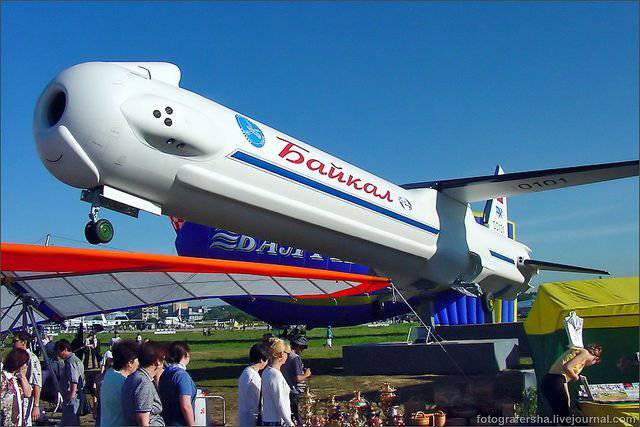
The proposed MRKS-1 system will be two-step. Its main purpose is to launch absolutely any spacecraft (transport, manned, automatic) weighing up to 25 – 35 tons into the near-earth orbit, both actually existing and in the process of creation. The payload weight put into orbit is greater than that of the Protons. However, the fundamental difference from existing launch vehicles will be different. System MRX-1 will not be disposable. Its 1 stage will not burn in the atmosphere or fall to the ground as a set of debris. Having dispersed the 2 th stage (is one-time) and the payload, the 1 stage will land like the space shuttles of the 20th century. Today it is the most promising path for the development of space transportation systems.
In practice, this project is a phased modernization of the Angara, a one-time launch vehicle currently being created. Actually, the project MRKS-1 itself was born as a further development of the project of the GKNPTs them. Khrunichev, where together with NPO Molniya, a reusable accelerator 1 of the Angara launch vehicle was created, designated as “Baikal” (for the first time, the layout of Baikal was also shown at MAKS-2001). “Baikal” used the same automatic control system, which allowed the Soviet space shuttle “Buran” to fly without a crew on board. This system provides flight support at all its stages - from the moment of launch to the landing of the vehicle on the airfield, this system will be adapted for the MRX-1.
In contrast to the Baikal project, the MRX-1 will not have folding planes (wings), but fixed ones. Such a technical solution will reduce the likelihood of emergency situations when the apparatus enters the landing trajectory. But the recently tested design of a reusable accelerator will still undergo changes. As Sergey Drozdov, who is the head of the aerothermodynamics department of high-speed aircraft TsAGI, noted, the specialists were “surprised by the high heat fluxes on the wing center section, which undoubtedly would entail a change in the design of the apparatus”. In September-October of the current year, the model MRKS-1 will pass a series of tests in transonic and hypersonic wind tunnels.
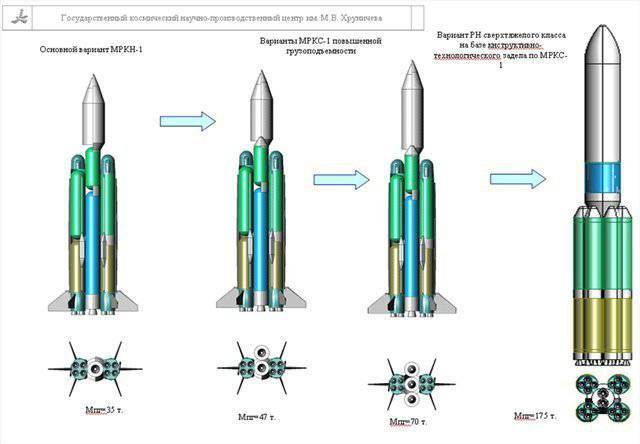
At the 2 stage of the reusable program implementation, they plan to make the 2 stage as well, and the mass of the payload put into space should increase to 60 tons. But even the development of a reusable accelerator with only the 1 stage is already a real breakthrough in the development of modern space transportation systems. And the most important thing is that Russia is moving towards this breakthrough, retaining its status as one of the leading world space powers.
Today, MRKS-1 is considered as a universal multi-purpose tool designed for launching spacecraft and multi-purpose payloads into man-made orbit, manned and cargo ships under man-made outer space exploration programs, exploration of the Moon and Mars, as well as other planets of our Solar System .
The structure of MRKS-1 includes a returnable missile unit (VRB), which is a reusable accelerator of stage I, a disposable accelerator of stage II, and a space warhead (CGM). VRB and accelerator II stages dock with each other in a packet scheme. Modifications of MRCs with different payloads (mass of cargo delivered to a low reference orbit from 20 to 60 tons) are proposed to be built taking into account unified accelerators of stages I and II using a single ground-based complex. What in the future will allow to ensure in practice a reduction in the laboriousness of work in a technical position, maximum serial production and the possibility of developing an economically efficient family of space carriers based on basic modules.
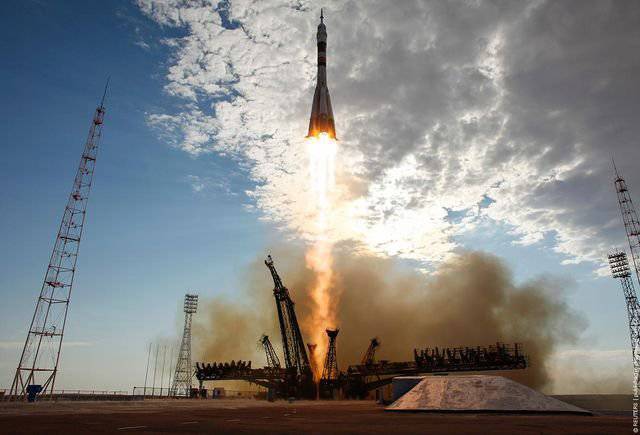
Development and construction of a family of MRKS-1 of different payloads on the basis of unified disposable and reusable stages that will meet the requirements for promising space transportation systems, and capable of very high performance and reliability in solving the tasks of launching both unique and expensive space objects and serial ones spacecraft can be a very serious alternative in a series of launch vehicles of a new generation that will be operated over and a long time in the twenty-first century.
At present, TsAGI specialists have already managed to evaluate the rational frequency rate of the application of the first stage of the MRKS-1, as well as the options for demonstrators of the returned missile blocks and the need for their implementation. The return stage I of the MRX-1 will ensure a high level of safety and reliability and completely abandon the identification of areas of incidence of detachable parts, which will significantly increase the efficiency of execution of promising commercial programs. The above advantages for Russia are extremely important, as for the only state in the world that has the continental location of existing and future space centers.
TsAGI believes that the creation of the project MRKS-1 is a qualitatively new step in the design of promising reusable space launch vehicles. Such systems fully correspond to the level of development of rocket and space technology of the 21st century and have significantly higher rates of economic efficiency.
Information sources:
-http: //www.odnako.org/blogs/show_27384
-http: //readings.gmik.ru/lecture/2010-KONTSEPTSIYA-GKNPTS-IM-MV-HRUNICHEVA-PO-SOZDANIYU-MNOGORAZOVOY-RAKETNO-KOSMICHESKOY-SISTEMI-PERVOGO-ETAPA
-http: //novosti-kosmonavtiki.ru/forum/forum13/topic10696
Information